
The new Ford Mustang squares off with its old nemesis the Chevrolet Camaro in California’s high Sierras.
THUS it was written: Lee Iacocca’s pen smote the boardroom table and up popped the Ford Mustang. It stopped the 1964 World’s Fair in New York cold on debut, and then created an entirely new class of American sports cars. A money monsoon fell on the bean-counters at Ford’s Glass House for the two-and-a-half years it took mighty General Motors to respond with its Chevrolet Camaro, and the two cars have been at each other’s throats ever since.
Neither the Mustang nor the Camaro, nor even the Cougars and Challengers and Javelins and ’Cudas that followed, would sway Enzo Ferrari in his firm conviction that “the only good sports car America ever built was the Jeep”. But to deny the charms of the pony car in all its peculiarly American excess is to have the most cynical view of cars in general.
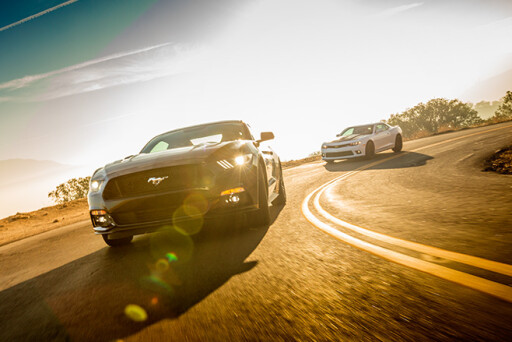 The survival of both this Mustang and Camaro into the second decade of the 21st century is a thumb to the nose for those long-dead pessimists from the past, those who thought the oil would be gone by now, leaving the world a grey, cheerless dystopia run by apes. Mind you, the persistence of these cars would also have disappointed those long-dead optimists who thought that by 2015 we’d all be winging around in saucers powered by cold fusion.
The survival of both this Mustang and Camaro into the second decade of the 21st century is a thumb to the nose for those long-dead pessimists from the past, those who thought the oil would be gone by now, leaving the world a grey, cheerless dystopia run by apes. Mind you, the persistence of these cars would also have disappointed those long-dead optimists who thought that by 2015 we’d all be winging around in saucers powered by cold fusion.
The future reliably frustrates all attempts at prediction, and all that really matters is this: today, the sun rose on two pony cars – one brand new, one still a couple of years away from a re-boot – that incorporate the best environmental protections, safety technology and street performance that the industry can muster at an affordable price. And they retreat not one iota from the promise of freedom and personal expression made by Iacocca’s original Mustang in 1964.
 So we assembled a pair of examples – V8s only, please – and sent them up-country in California to see which carries the muscle-car torch better in this era of Instagrammed iPhone electromania. Due to scheduling snafus, the Mustang GT with its 324kW 5.0-litre quad-cam V8 arrived with a six-speed automatic, while the Chevy Camaro SS 1LE with its 318 kW 6.2-litre pushrod small-block rumbled in with a six-speed manual. Never mind, the performance is fairly matched these days, automatics to manuals, and we’ve driven enough of all versions to render an unbiased verdict.
So we assembled a pair of examples – V8s only, please – and sent them up-country in California to see which carries the muscle-car torch better in this era of Instagrammed iPhone electromania. Due to scheduling snafus, the Mustang GT with its 324kW 5.0-litre quad-cam V8 arrived with a six-speed automatic, while the Chevy Camaro SS 1LE with its 318 kW 6.2-litre pushrod small-block rumbled in with a six-speed manual. Never mind, the performance is fairly matched these days, automatics to manuals, and we’ve driven enough of all versions to render an unbiased verdict.
Fittingly, the Mustang is not only the first pony car, but the only one to survive in an unbroken (though not unsullied) bloodline from the original. Its record, especially since the 1980s, has been one of continuous gradual improvement from year to year, sometimes so minute as to virtually go unnoticed.
With the 2015 overhaul, done with a gaze fixed steadily on the target of increased international appeal, the model breaks its slow trot of progress and instead makes one giant leap for Mustang-kind. Chief engineer Dave Pericak said the initial plan, to leverage more of Ford’s existing hardware, was eventually shelved as engineers struggled to make a new-enough Mustang from the bones of the old one. Ultimately, he says, they were given a freer hand to “make a Mustang that we can put a 50th anniversary badge on and be proud of”.
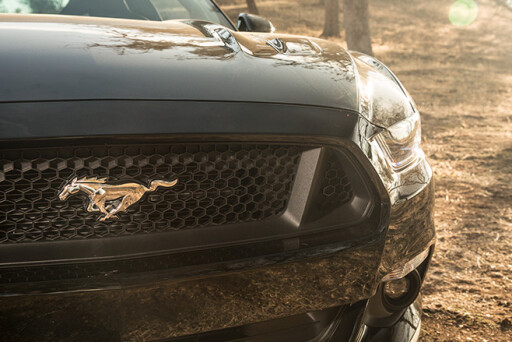 They did indeed. Though the wheelbase stayed the same for manufacturing simplicity, the Mustang’s wheels now seem pushed out and the greenhouse pressed down. Straight edges have melted into alluring curves, such that the eye slides down that raked roofline like it’s the strapless back of Miranda Kerr. The Mustang has a skin exquisitely shaped to both move the design forward and preserve an unmistakable link to ponies past.
They did indeed. Though the wheelbase stayed the same for manufacturing simplicity, the Mustang’s wheels now seem pushed out and the greenhouse pressed down. Straight edges have melted into alluring curves, such that the eye slides down that raked roofline like it’s the strapless back of Miranda Kerr. The Mustang has a skin exquisitely shaped to both move the design forward and preserve an unmistakable link to ponies past.
Underneath, Ford decided to finally ditch the solid axle for an independent rear suspension, which in turn required a rethink of the strut front suspension. And if they were doing that, they thought, might as well look at the subframes. And the brakes. And the steering linkages and cross-bracing. And so on, until Ford pretty much had a new car.
The Camaro was facelifted in 2013, followed by the introduction of a couple of new and ever more weaponised models, including this SS 1LE with its meaner suspension, and the totally track-rat Z/28. The top power dog remains the 433kW ZL1, however all will be short-lived as a new Camaro breaks cover in 2016 sporting the LT4 V8 from the current Corvette.
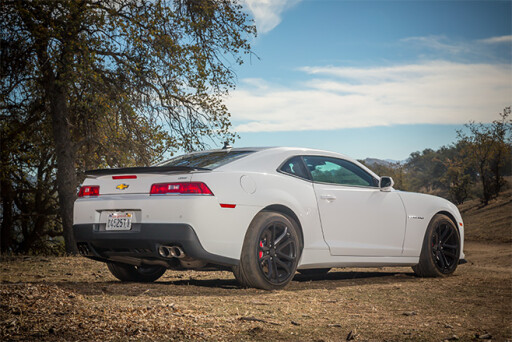 The Camaro is a Holden Commodore VE/VF sedan wearing a coupe costume, which makes it a little longer and a smidge heavier than the Mustang. As with the Ford, the squared-up Camaro looks to the 1960s for styling inspiration, yet fully embraces the Transformers era with its slotted, space-robot face. The sheetmetal is intentionally slabby and fortress-like, as if an interstellar craft has been made out of a Civil War ironclad. It is a perfect brutal yang to the softer yin of the curvaceous Mustang, and looks the business painted white with its bonnet in black like an aircraft’s anti-glare panel.
The Camaro is a Holden Commodore VE/VF sedan wearing a coupe costume, which makes it a little longer and a smidge heavier than the Mustang. As with the Ford, the squared-up Camaro looks to the 1960s for styling inspiration, yet fully embraces the Transformers era with its slotted, space-robot face. The sheetmetal is intentionally slabby and fortress-like, as if an interstellar craft has been made out of a Civil War ironclad. It is a perfect brutal yang to the softer yin of the curvaceous Mustang, and looks the business painted white with its bonnet in black like an aircraft’s anti-glare panel.
Inside, the Mustang is the new kid and it shows, with the latest and greatest materials and electronic frippery, such as collision warning, parking sensors and a cross-traffic alert that prevents you from backing out the driveway into an oncoming petrol tanker. Drop the extra $US4000 ($A4760) for a GT Premium and you’re swaddled in soft-touch leather, aluminum trim and chrome accents. Click the unlock button on the fob and tiny lamps hidden in the side-view mirrors project the galloping Mustang logo on the ground next to the car, a great Batman-style party trick.
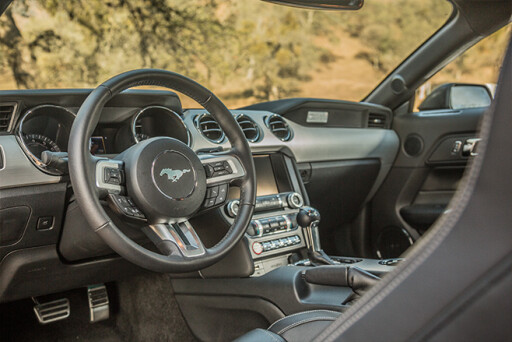 The dash panel of burnished alloy runs door-to-door and provides a fitting stage for the gauges, buttons and high-res Ford SYNC screen with MyFord Touch. Annotations such as ‘Ground Speed’ on the speedo and ‘Revolutions Per Minute’ on the tacho seem a little precious, but muscle-car buyers tend to like some theatre in their machines.
The dash panel of burnished alloy runs door-to-door and provides a fitting stage for the gauges, buttons and high-res Ford SYNC screen with MyFord Touch. Annotations such as ‘Ground Speed’ on the speedo and ‘Revolutions Per Minute’ on the tacho seem a little precious, but muscle-car buyers tend to like some theatre in their machines.
The screen in the Mustang’s cluster can be configured to digitally render all kinds of fascinating gauges you didn’t know you needed, such as twitching dial indicators for the air/fuel ratio, intake boost/vacuum (though there’s no boost on this version, of course) or inlet-air temperature. It’s with this screen and accompanying steering-wheel buttons that you engage the track mode for the stability control and the line-lock function, which at a standstill allows you to electronically lock just the front brakes and barbecue the rear tyres for up to 15 seconds. A panel toggle lets you dial up three levels of steering effort.
By comparison, the Camaro looks like public infrastructure inside, even with its optional two-grand Recaro buckets. The phone company has cars with fancier trim than this. Ponds and rivers of plain black plastic stand in for design, though swathes of synthetic suede, especially wrapping the shifter and steering wheel rim with attractive herring-bone stitching, at least provide a sense of performance authenticity at the touch points. If you didn’t like the Camaro’s green-lit gauge presentation when it was new, staring wide-eyed at you like Elton John in his mega-sunnies heyday, you won’t love it any more today as it rapidly approaches retirement.
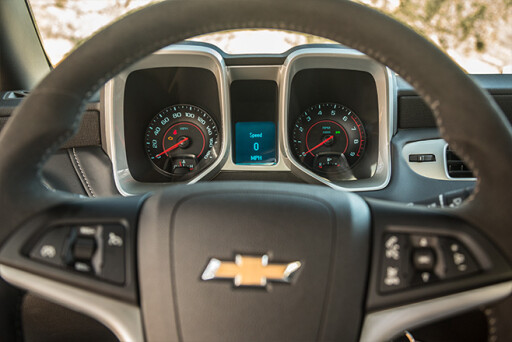 Still, it’s a cockpit that favours business over flash. The visibility problems with the bunker-topped Camaro remain unchanged, but the controls are satisfying and efficient. Though the shifter is short, it moves to a light effort and with a precise compass heading for the next gate. The brakes and steering answer with alert responses, while the clutch closes with a relaxed smoothness that makes gearchanges seamless.
Still, it’s a cockpit that favours business over flash. The visibility problems with the bunker-topped Camaro remain unchanged, but the controls are satisfying and efficient. Though the shifter is short, it moves to a light effort and with a precise compass heading for the next gate. The brakes and steering answer with alert responses, while the clutch closes with a relaxed smoothness that makes gearchanges seamless.
Of these two cars, the Camaro is the corner killer. First, Chevy fits blocky Goodyear Eagle F1 Supercar G2 tyres to the 20-inch rims of the 1LE spec, which combined with the stiff suspension package makes this SS a sticky, stable handler. The fierce turn-in and cornering grip indicate how deeply the Camaro sinks its claws into the pavement. With all that gum on the road, it’s difficult to even break the rear end sideways for the photographer. The downside is a crashing expressway ride complemented by extra thrum from those big rubber rolling pins.
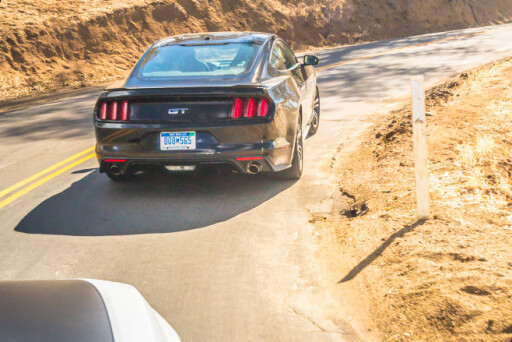 In comparison, the Mustang is a floater. It starts with a relatively pillowy suspension tune that makes the Ford the hands-down choice for long highway trips, but a soggier steed up in the high country. At times over pitching pavement, the nose develops a distinctly vintage circular bob as the 1730kg car shimmies and porpoises at the same time, the bumps working over the jelly springs. Worse, Ford fits standard all-season Pirellis that give the car a tenuous connection to the asphalt. Many a fine switchback dissolves into bawling understeer with these tyres, though they can be replaced with P Zero summer rubber as a standalone option or by opting for the $US2495 ($A2970) GT Performance Pack, which is only available with the manual transmission and also includes a stouter suspension tune, a 3.73:1 Torsen limited-slipper, Brembo six-piston front brake calipers and other goodies.
In comparison, the Mustang is a floater. It starts with a relatively pillowy suspension tune that makes the Ford the hands-down choice for long highway trips, but a soggier steed up in the high country. At times over pitching pavement, the nose develops a distinctly vintage circular bob as the 1730kg car shimmies and porpoises at the same time, the bumps working over the jelly springs. Worse, Ford fits standard all-season Pirellis that give the car a tenuous connection to the asphalt. Many a fine switchback dissolves into bawling understeer with these tyres, though they can be replaced with P Zero summer rubber as a standalone option or by opting for the $US2495 ($A2970) GT Performance Pack, which is only available with the manual transmission and also includes a stouter suspension tune, a 3.73:1 Torsen limited-slipper, Brembo six-piston front brake calipers and other goodies.
The Mustang GT isn’t really a bad handler; its base suspension is just set on the soft side. It is a perfect pleasure to drive at seven-tenths, with direct steering and reassuring brakes. Ford’s engineers obviously left overhead clearance in the suspension for performance tunes and future models such as the already announced Shelby GT350 and a Boss that is almost certainly coming. That frees up the GT to be just that, a comfy, everyday gran turismo.
Both cars make the right big-bore snorts from their V8s, though the Mustang’s oddly rhythmic puff-puff from its twin tailpipes at idle sounds almost computer-generated. They’re evenly matched to 100km/h, with times in the mid-fours, and to 400m. Separate testing of a six-speed manual Mustang GT proves the automatic suffers nothing in acceleration and would be even quicker if launched on proper tyres. They also burned fuel at similar rates, the Mustang edging the Camaro.
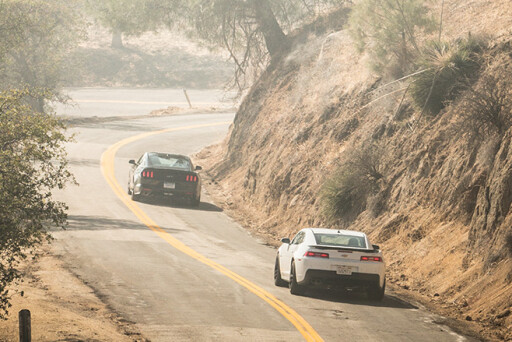 Despite the straight-line parity, the Camaro feels slower. Maybe it’s because you’re sealed up in it more thoroughly, or because the stiffer suspension stays flatter under acceleration, but the dropped hammer leaves you with a “this is it?” feeling. There’s more drama in the Mustang as the car squats noticeably and its cammier engine races for its 7000rpm redline. And the new Mustang augments its engine bawl with vroom noises played on the car’s sound system, a la BMW.
Despite the straight-line parity, the Camaro feels slower. Maybe it’s because you’re sealed up in it more thoroughly, or because the stiffer suspension stays flatter under acceleration, but the dropped hammer leaves you with a “this is it?” feeling. There’s more drama in the Mustang as the car squats noticeably and its cammier engine races for its 7000rpm redline. And the new Mustang augments its engine bawl with vroom noises played on the car’s sound system, a la BMW.
Our Camaro is definitely the most nostalgic. Even with its sharper handling, it’s the most I’ll-be-18-forever car of the pair, recalling hot summer nights on
long-gone main streets and some of the nuisances of muscle cars that you didn’t mind or even notice when you were a teenager.
This Mustang, conversely, is from people who figure that if you’ve got that much to spend, they have to persuade you not only against buying a Camaro, but also an Audi A5 or a BMW 428i. In America, at least.
The many-button Mustang wants to play in the international sand box, albeit with a distinctly American girth and attitude. The Camaro has international roots but has gone completely native, as American as guacamole on a pizza. But even America is ready for something a little less old school, and the Mustang is it.
Four for economy
 WHILE the 5.0-litre Coyote V8 is the Mustang’s top engine until the Shelby comes along, Ford really wants to talk about the new and financially risky 2.3-litre EcoBoost four, good for 231kW and 434Nm.
WHILE the 5.0-litre Coyote V8 is the Mustang’s top engine until the Shelby comes along, Ford really wants to talk about the new and financially risky 2.3-litre EcoBoost four, good for 231kW and 434Nm.
Muscle-car buyers only see a four-potter as half a V8, but Ford figures the potential fuel economy gain (9.4L/100km in federal testing versus 12.4 for the V8) should help it win over up to 40 percent of customers. We’ll see; US fuel prices have dropped significantly since the engine’s debut.
 After experimenting with displacements down to 1.8 litres, Ford settled on a long-stroke four with (coincidentally, they say) an historically significant displacement the same as the last turbo Mustang, the 1984-86 SVO.
After experimenting with displacements down to 1.8 litres, Ford settled on a long-stroke four with (coincidentally, they say) an historically significant displacement the same as the last turbo Mustang, the 1984-86 SVO.
However, if you come to the ’States and rent a Mustang convertible for the required drive up California’s Highway 1, as many visitors do, you’re most likely to get the entry-level 224kW 3.7-litre V6.
Small-block survival
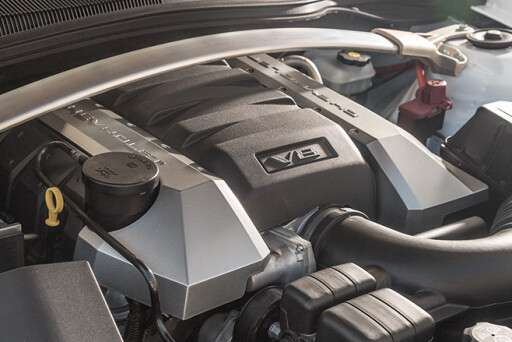 THE Camaro turns 50 in 2016 and will be the only muscle car with common bore-centre spacing from the beginning. The small-block V8 was such a successful design that GM is still producing variants with an alphabet soup of codenames.
THE Camaro turns 50 in 2016 and will be the only muscle car with common bore-centre spacing from the beginning. The small-block V8 was such a successful design that GM is still producing variants with an alphabet soup of codenames.
Current Camaro line-up includes the 298kW L99 on automatic SS and 318kW LS3 for manuals, while Z/28’s 7.0-litre LS7 makes 376kW and ZL1’s supercharged 6.2-litre LSA produces 427kW. In 2016, Camaro gets the Corvette’s new LT1 and its supercharged LT4 variant, which update the small-block with direct injection and cylinder deactivation.
No doubt Chevy is closely watching the sales of the EcoBoost Mustang to see if buyers would swallow a four-cylinder Camaro. Either way, there likely won’t be one at launch.

COMMENTS